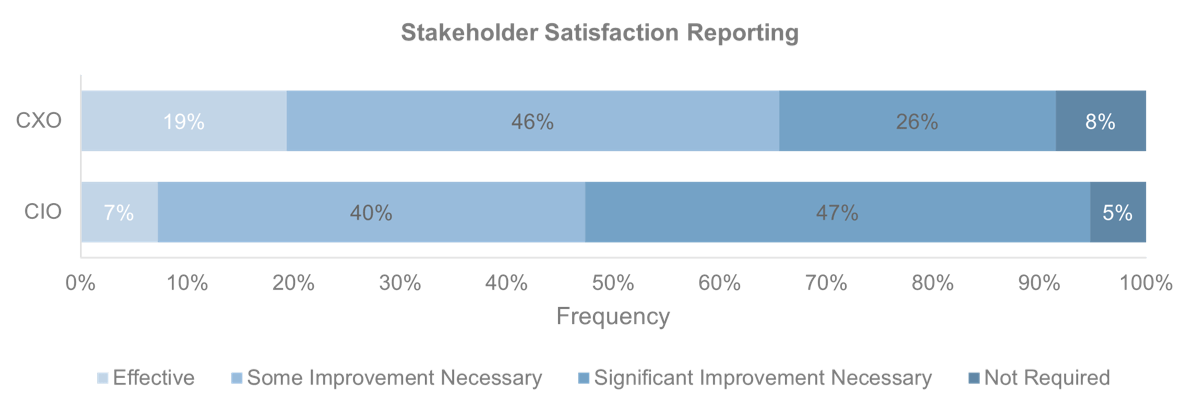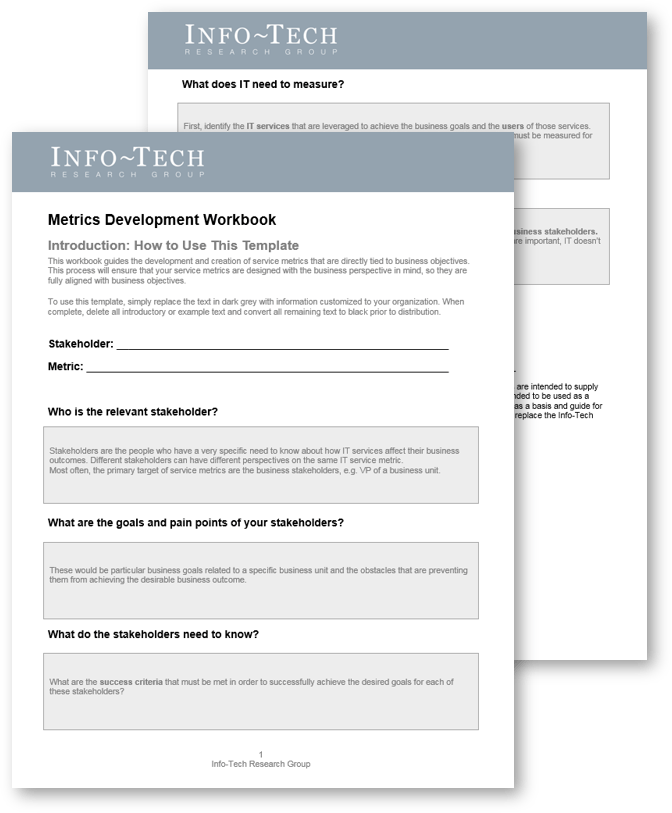- IT organizations measure services from a technology perspective but rarely from a business goal or outcome perspective.
- Most organizations do a poor job of identifying and measuring service outcomes over the duration of a service’s lifecycle – never ensuring the services remain valuable and meet expected long-term ROI.
Our Advice
Critical Insight
- Service metrics are critical to ensuring alignment of IT service performance and business service value achievement.
- Service metrics reinforce positive business and end-user relationships by providing user-centric information that drives responsiveness and consistent service improvement.
- Poorly designed metrics drive unintended and unproductive behaviors that have negative impacts on IT and produce negative service outcomes.
Impact and Result
Effective service metrics will provide the following service gains:
- Confirm service performance and identify gaps.
- Drive service improvement to maximize service value.
- Validate performance improvements while quantifying and demonstrating business value.
- Ensure service reporting aligns with end-user experience.
- Achieve and confirm process and regulatory compliance.
Which will translate into the following relationship gains:
- Embed IT into business value achievement.
- Improve the relationship between the business and IT.
- Achieve higher customer satisfaction (happier end users receiving expected service, the business is able to identify how things are really performing).
- Reinforce desirable actions and behaviors from both IT and the business.
Member Testimonials
After each Info-Tech experience, we ask our members to quantify the real-time savings, monetary impact, and project improvements our research helped them achieve. See our top member experiences for this blueprint and what our clients have to say.
9.6/10
Overall Impact
$27,982
Average $ Saved
31
Average Days Saved
Client
Experience
Impact
$ Saved
Days Saved
City of Fairfield
Workshop
10/10
$64,999
47
Team learned about setting up outcome based Metrics and will be able to apply it to the daily operations.
Hunt Consolidated, Inc.
Workshop
10/10
$32,499
10
Paul's insights and facilitation was invaluable.
Arizona Department of Education
Guided Implementation
10/10
$64,999
23
National Arts Centre Canada
Guided Implementation
8/10
$2,000
5
Palm Beach State College
Guided Implementation
9/10
N/A
20
Government of Bermuda
Guided Implementation
10/10
N/A
N/A
No way to determine time or budget impact at this time. Too soon. Love the conversation and have good direction on where to start.
Altarum Institute
Guided Implementation
10/10
N/A
1
Shelby County Government
Workshop
10/10
N/A
120
The level of real-world valuable insight Valence, the facilitator, brought to the workshop had great value for the team overall. After this worksh... Read More
Dollar General
Guided Implementation
10/10
$2,519
50
Open Text Corporation
Guided Implementation
9/10
N/A
5
University of Ottawa
Workshop
8/10
$25,000
14
Best: Adequate time to do the work. being able to afford the time to dig deeper into the KPIs. Executive review at the end. Good management of doin... Read More
Tulane University
Guided Implementation
10/10
$14,259
50
Valence was very knowledgable and helpful. I'm pleased with the level of service.
Office of the Attorney General
Guided Implementation
10/10
$12,292
10
Best part: - The analyst used examples I'm familiar with (applications and databases, human body, etc.) so it was relatable and easier to underst... Read More
Allens Operations Pty Ltd.
Guided Implementation
8/10
N/A
N/A
Akin Gump Strauss Hauer & Feld LLP
Guided Implementation
9/10
N/A
6
University of Wisconsin-Madison
Guided Implementation
10/10
$99,166
60
Best: Tony gaining understanding and validating our experience and position in developing a metric model. Framing how we can start to use the metr... Read More
Clark Pacific
Guided Implementation
9/10
$509K
N/A

Performance Measurement
Measure IT right and measure it well.
This course makes up part of the Strategy & Governance Certificate.
- Course Modules: 4
- Estimated Completion Time: 1.5-2 hours
- Featured Analysts:
- Gord Harrison, Senior Vice President, Research
- Valence Howden, Principal Research Director, CIO Practice
Workshop: Develop Meaningful Service Metrics
Workshops offer an easy way to accelerate your project. If you are unable to do the project yourself, and a Guided Implementation isn't enough, we offer low-cost delivery of our project workshops. We take you through every phase of your project and ensure that you have a roadmap in place to complete your project successfully.
Module 1: Design the Metrics
The Purpose
- Define stakeholder needs for IT based on their success criteria and identify IT services that are tied to the delivery of business outcomes.
- Derive meaningful service metrics based on identified IT services and validate that metrics can be collected and measured.
Key Benefits Achieved
- Design meaningful service metrics from stakeholder needs.
- Validate that metrics can be collected and measured.
Activities
Outputs
Determine stakeholder needs, goals, and pain points.
- Understand stakeholder priorities
Determine the success criteria and related IT services.
- Adopt a business-centric perspective to align IT and business views
Derive the service metrics.
- Derive meaningful business metrics that are relevant to the stakeholders
Validate the data collection process.
- Determine if and how the identified metrics can be collected and measured
Validate metrics with stakeholders.
- Establish a feedback mechanism to have business stakeholders validate the meaningfulness of the metrics
Module 2: Design Reports and Dashboards
The Purpose
- Determine the most appropriate presentation format based on stakeholder needs.
Key Benefits Achieved
- Ensure the metrics are presented in the most interesting and stakeholder-centric way possible to guarantee that they are read and used.
Activities
Outputs
Understand the different presentation options.
- Learn about infographic, scorecard, formal report, and dashboard presentation options
Assess stakeholder needs for information.
- Determine how stakeholders would like to view information and how the metrics can be presented to aid decision making
Select and design the metric report.
- Select the most appropriate presentation format and create a rough draft of how the report should look
Module 3: Implement, Track, and Maintain Your Metrics
The Purpose
- Run a pilot with a smaller sample of defined service metrics to validate your approach.
- Make refinements to the implementation and maintenance processes prior to activating all service metrics.
Key Benefits Achieved
- High user acceptance and usability of the metrics.
- Processes of identifying and presenting metrics are continuously validated and improved.
Activities
Outputs
Select the pilot metrics.
- Select the metrics that should be first implemented based on urgency and impact
- Complete the service intake form for a specific initiative
Gather data and set initial targets.
- Create a process to gather data, measure baselines, and set initial targets
Generate the reports and validate with stakeholders.
- Establish a process to receive feedback from the business stakeholders once the report is generated
Implement the service metrics program.
- Identify the approach to implement the metrics program across the organization
Track and maintain the metrics program.
- Set up mechanism to ensure the success of the metrics program by assessing process adherence and process validity
 N=364
N=364
 N=364
N=364











 Develop a Plan to Pilot Enterprise Service Management
Develop a Plan to Pilot Enterprise Service Management
 Create a Service Management Roadmap
Create a Service Management Roadmap
 Design and Build a User-Facing Service Catalog
Design and Build a User-Facing Service Catalog
 Create an IT View of the Service Catalog
Create an IT View of the Service Catalog
 Initiate Your Service Management Program
Initiate Your Service Management Program
 Develop Meaningful Service Metrics
Develop Meaningful Service Metrics
 IT Service Management Selection Guide
IT Service Management Selection Guide
 Service Management Integration With Agile Practices
Service Management Integration With Agile Practices
 Define Your Enterprise IT and Digital Services
Define Your Enterprise IT and Digital Services